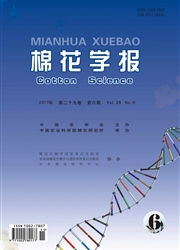

 中文摘要:
中文摘要:
选用辽棉19号(生育期125d)和新棉33t3(生育期135d)为材料,于2009年在东北特早熟棉区(辽宁辽阳,41°26'N,123°14’E)设置棉花种植密度(7.50万,9.75万,12.00万株·hm-2)和施氮量(0,120,240,360,480kg·hm-2)试验,研究不同种植密度下棉花氮临界浓度的变化并建立东北特早熟棉区不同群体棉花氨临界浓度稀释模型。结果表明:不同种植密度下棉花氮临界浓度与地上部最大生物量间均符合幂函数关系(N=aWb).模型参数a,b值在不同种植密度下存在差异。同一品种生产相同生物量的需氮量随种植密度的增加而增大,而同一密度下生产相同的生物量新棉3313的氮素吸收量高于辽棉19号。基于氮临界浓度稀释条件下的异速生长参数,氨素营养指数以及动态氮素临界累积量等指标得到的东北特早熟棉区不同群体适宜施氮量的结果一致,表明9.75万株-hm-2密度下240kg·hm-2施氮量为东北特早熟棉区最佳种植密度和施氮量。
 英文摘要:
英文摘要:
To determine the critical nitrogen(N) concentration dilution curve for cotton grown in the extremely early-maturation region of northeast China, field experiments were carried out in Liaoyang (41 °26'N, 123 °14'E) with cultivars of Liaomian 19 and NuCOTN 33B. Three plant population densities (7.5×10^4, 9.75×10^4, and 12×10^4 plants.hm-2) and five nitrogen rates (0, 120, 240, 360, and 480 kg. hm-2) were applied. The results showed that the relationship between shoot dry matter and critical N concentration could be described by a power equation(N=aWb). The coefficients a and b of the critical N dilution curve for cotton depended on cotton genotype and plant density. At higher plant densities, cotton plants had a higher capacity for N accumulation in shoot biomass than at lower densities. Variety NuCOTN 33B had a higher capacity for N accumulation in shoot biomass than did Liaomian 19 at the same plant density. Based on the critical N dilution model and the allometric relationship between N uptake and dry matter accumulation in shoots, models for potential growth and yield were developed for N nutrition index(NN/) and for N demand at different growth stages. According to the allometric growth coefficient, NNI, and N accumulation rate below the critical N concentration, we confirmed that the optimal rate of N application at a density of 9.75 ×10^4 plants, hma was 240 kg.hm-2, which was lower than that at densities of 7.5 × 10^4 or 12 × 10^4 plants.hm-2 in the cotton extremely early-maturation region in northeast China.
 同期刊论文项目
同期刊论文项目
 同项目期刊论文
同项目期刊论文
 Physiological Mechanism of Sucrose Metabolism in Cotton Fiber and Fiber Strength Regulated by Nitrog
Physiological Mechanism of Sucrose Metabolism in Cotton Fiber and Fiber Strength Regulated by Nitrog Modeling boll maturation period, seed growth, protein, and oil content of cotton (Gossypium hirsutum
Modeling boll maturation period, seed growth, protein, and oil content of cotton (Gossypium hirsutum 期刊信息
期刊信息
